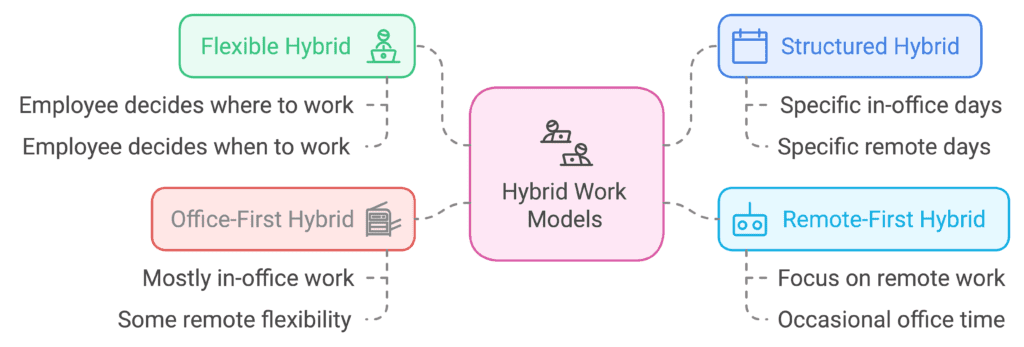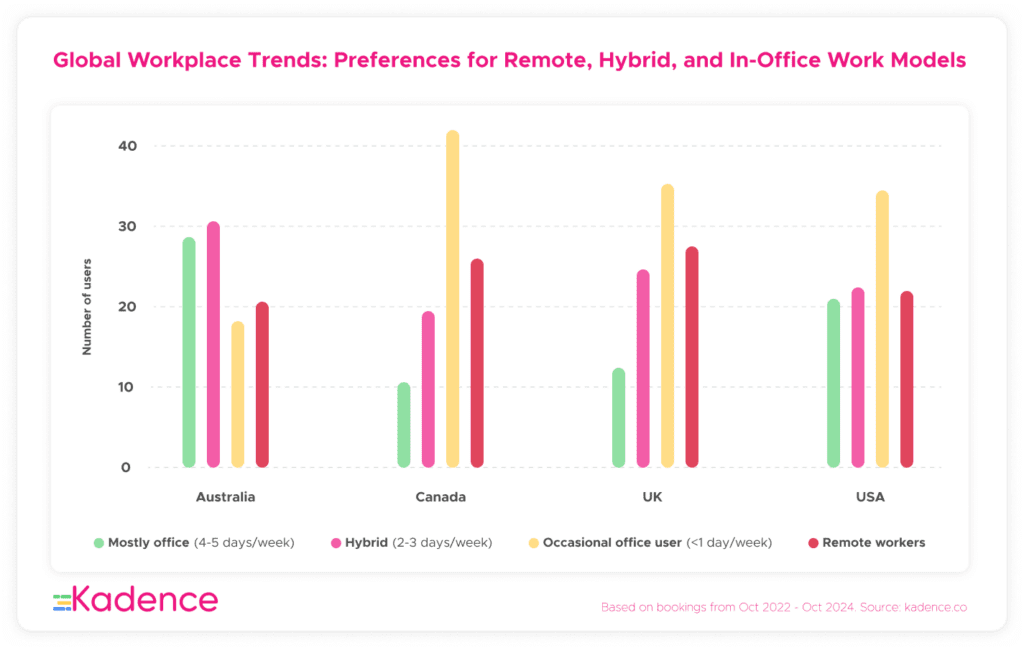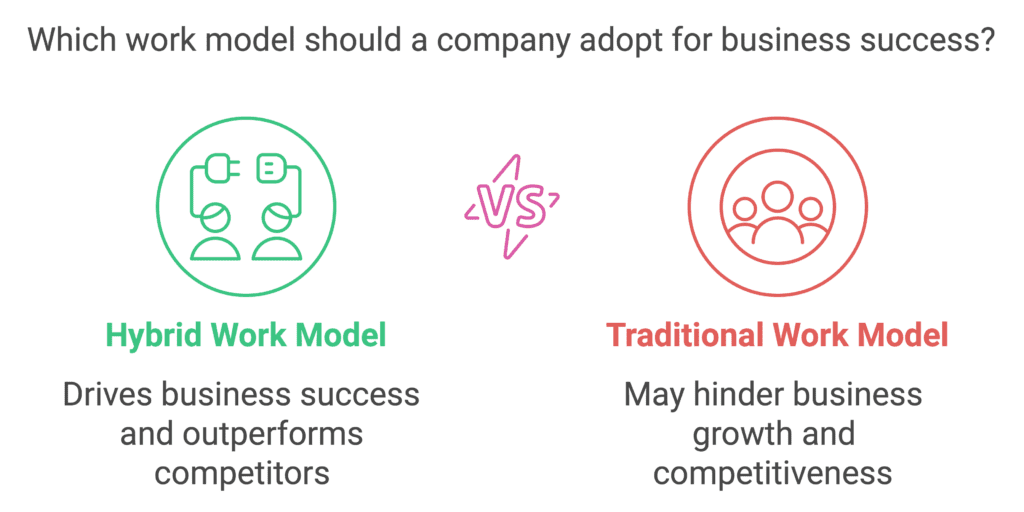Hybrid work is no longer just a buzzword—it’s how many of us work today. Combining the best of in-office collaboration with the freedom of remote work, this model is reshaping the workplace. But making hybrid work successful requires more than just setting up Zoom links and hot desks—it’s about building a system that benefits both employees and businesses.
Let’s dive into what hybrid work really is, why it works, and how to make it happen.
What is Hybrid Work?
At its core, hybrid work means employees split their time between the office and wherever else they’re productive—home, a coffee shop, or even a coworking space.
There’s no one-size-fits-all approach, but here are the most common setups:

Why Are There So Many Versions?
Flexibility is key. For some teams, daily in-office collaboration is essential. For others, asynchronous workflows and remote independence rule. Hybrid work adapts to organizational needs while still prioritizing flexibility for employees.
Our customers across the world use a variety of different hybrid work models.

Pro Tip: Start by surveying your team to determine which hybrid model fits best. Every company and workforce is unique.
The Pros of a Hybrid Work Model
Hybrid work isn’t just a nice perk—it’s a win-win for employees and employers. Here’s why it’s catching on:
- Boost Productivity: People work best in different environments. Some thrive in bustling office settings, while others find their groove in a quiet home workspace. Hybrid work lets employees pick the setting that works for their task at hand—brainstorming in the office, deep focus work at home.
- Supports Work-Life Balance: Flexibility means employees can manage life’s demands—whether that’s picking up kids from school, scheduling medical appointments, or squeezing in a midday workout. By reducing the stress of juggling personal and professional responsibilities, employees can show up as their best selves.
- Attracts and Retains Top Talent: The job market is competitive, and offering hybrid work is a major advantage. According to a recent Gallup survey, nearly 6 in 10 employees prefer jobs with flexible work options. Want the best candidate in Texas, New York, or Florida? Hybrid work expands your reach beyond your local city.
- Saves Money: Hybrid work can save businesses big bucks. By reducing office space needs, companies can lower rent, utilities, and office maintenance costs. Employees also save money by cutting commuting expenses, eating out less, and spending fewer hours stuck in traffic.
Real-World Example: Dropbox embraced a hybrid model they call “Virtual First.” Employees can work from anywhere, and offices have been transformed into collaborative spaces. The result? More engagement and cost savings on underutilized office space.
The Real Talk: Challenges of Hybrid Work
Let’s not sugarcoat it—hybrid work comes with its own hurdles. Here’s what to watch out for:
- Communication Gaps: It’s easy for remote employees to feel out of the loop when half the team is in the office. Without intentional communication strategies, teams risk siloed workflows and misunderstandings.
- Keeping Culture Alive: Team-building can be tricky when employees are scattered across locations. Virtual happy hours are fun, but they don’t fully replace the casual conversations and connections that happen organically in the office.
- Fairness and Equity: Not all employees have the same resources at home. Some may lack quiet workspaces, reliable internet, or the right tech tools. Additionally, there’s the risk of “proximity bias,” where managers may unconsciously favor in-office employees over remote workers when assigning promotions or projects.
Solution: Ensure remote employees have access to the same opportunities, training, and recognition as their in-office peers. Using Kadence’s tools, you can create equitable schedules that prioritize collaboration days, so everyone has the chance to connect and contribute equally. Kadence also helps teams coordinate their in-office presence, ensuring remote workers are included in key moments and meetings. Pair this with anonymous performance reviews and regular one-on-ones to foster fairness and inclusivity across your hybrid workforce.
The Numbers Don’t Lie: Hybrid Work Model Data
The hybrid work trend is booming across the U.S., with new data proving it’s here to stay:
- Nearly 30% of U.S. employees now work in a hybrid setup, and this number is growing (Gallup).
- A Stanford University study found hybrid setups can slash employee turnover by 33%, thanks to better work-life balance and job satisfaction (Stanford News).
- Companies offering flexible work arrangements are 22% more likely to see higher revenue growth than those sticking to traditional in-office policies (Business Insider).
Takeaway: The hybrid model isn’t just a “nice to have”—it’s driving business success. Companies that embrace it are positioned to outperform their competitors.

How to Implement a Hybrid Work Model
So, how do you set your team up for hybrid success? Here’s how to make it happen:
- Set Clear Expectations: Ask key questions that ensure everyone is on the same page.
- Which days are employees in-office vs. remote? Give them choice and ask them them to communicate this through a software like Kadence.
- What’s the protocol for meetings—are they virtual by default?
- How do you communicate across time zones?
- Invest in the Right Tools: Equip your team with software and hardware that makes hybrid work seamless:
- Hybrid Management Tool: Kadence can help you and your team find your rhythm for work.
- Collaboration Tools: Slack, Microsoft Teams, or Asana for communication and task management.
- Video Conferencing: Zoom or Google Meet for face-to-face interactions.
- Cloud-Based Platforms: Google Drive or OneDrive for easy file sharing.
- Keep It Inclusive: Adopt a “remote-first” mindset for meetings to ensure all employees feel included. For example:
- Record meetings for employees in different time zones.
- Use collaborative tools like Miro to level the playing field for brainstorming sessions.
- Prioritize Well-Being: Hybrid work shouldn’t feel like “always-on” work. Encourage employees to
- Set boundaries
- Log off at reasonable hours
- Take mental health days when needed.

Pro Tip: Offer stipends for home office setups to ensure employees have ergonomic and efficient workspaces.
Case Studies: Hybrid Work Best Practices
MOO
MOO embraced hybrid work to improve office utilization and foster collaboration. Using Kadence’s tools, they identified patterns in workspace usage and optimized their spaces to support team collaboration while reducing overhead. Learn more about MOO’s success here.
Trip.com
Trip.com’s hybrid work experiment led to incredible results. Employee satisfaction soared, productivity increased, and the company saved millions in operational costs. Read the full story here.
GWI
GWI leveraged hybrid work to unlock productivity and improve employee engagement. By adopting Kadence, they empowered teams to coordinate in-office schedules efficiently, boosting collaboration while maintaining flexibility. This led to increased employee satisfaction and seamless collaboration between remote and office-based workers, proving that a well-executed hybrid model can foster both connection and productivity. Discover GWI’s hybrid work journey here.
Wrapping It Up: How Kadence Can Help You Succeed
Hybrid work isn’t just a trend—it’s the future. Done right, it can supercharge productivity, support well-being, and attract the best talent. But getting there takes the right tools, strategies, and insights.
That’s where Kadence comes in. Kadence helps companies unlock the full potential of hybrid work by offering:
- Workplace Scheduling: Simplify desk booking, team schedules, and meeting room reservations with an easy-to-use platform.
- Analytics and Insights: Use real-time data to optimize office space, improve collaboration, and reduce costs.
- Employee Empowerment: Kadence makes it easy for teams to coordinate schedules and choose the best work environments for their tasks.
With Kadence, you can overcome the common pitfalls of hybrid work—like communication gaps, culture challenges, and inefficiencies—and create a system that works for everyone.





